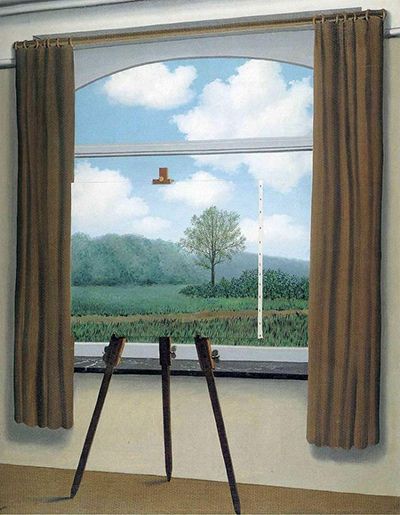Painted in 1933 by Belgian artist Rene Magritte, The Human Condition is an example of the surrealist movement of the time. It features an easel displayed in front of a window with heavy drapes.
On the easel is a painting identical to the scene outside to the point where it can take a moment for the eyes to take in what they are seeing. The painting (which is oil on canvas) is currently in the possession of the National Gallery of Art in Washington, DC, in the United States of America.
Very frequently Magritte would introduce the idea of hiding an object or scene behind another object, such as his examples of people with their faces covered in cloth or by apples.
In this case a new element is added; Magritte is hiding the scene beyond the easel with a painting of that exact scene. It is impossible to know whether it is accurate to what is behind it, or whether perhaps it displays an idealised scene, but it lines up enough that id does not let the viewer see what might be beyond.
This is an important element in Magritte's work; it forces the viewer to come to a new understanding of what they are looking at. After all, the image itself is not real. The scene outside of the window is the same piece of art as the painting on the easel within the painting, which means there is no real scene beyond the easel to be accurate or otherwise.
Looking at it this way, it helps give it the label of 'surreal' because it evokes a sense of discomfort within the mind as one considers the meaning of this and how it is affected (or not) by reality. These layers of meaning and forced thought on the part of the viewer is what has made Magritte's work so infamous and long-lasting.
Magritte also used the motif of paintings within his paintings quite often which is an interesting choice for a painter. He took something that is very common in usage for him but probably not for the viewer (the easel and the canvas) and puts it right into the image, often as a centrepiece. This almost seems to bring the art into itself.
This painting is very similar to another that was painted in 1935. This one is the earlier version and seems much busier in content than the clearer, more plain version painted later on.
In addition to being lighter in general, the 1035 version portrayed a beach scene with a black ball of some kind in the doorway. The colours in the two paintings are very different, but both are intended to give the viewer the unease that many surrealist paintings cause.
Many people who view Magritte's paintings attempt to see the artist's influence on the images, especially since he was popular in the time when psycho-analysis was becoming more mainstream.
There are suggestions that the duality of meaning in the paintings such as 'The Human Condition' show how Magritte attempts to disguise his inner self with an outer expression.
It is a possibility therefore that the name reflects this duality, though it may also represent the fact that the viewer instantly assumes the painting within the painting is hiding the scene beyond the image, despite the fact that the painting is in fact the image itself. This filling in of the gaps to the point of redundancy as well as seeking out patterns where there are none are common traits within humanity, and Magritte is an expert at exploiting them.
It is the huge amount of possibilities in meaning within any of Magritte's paintings that keep him such a popular artist even today with his place in art history confirmed. His use of simple images in complex ways keeps the mind active and at the same time provides an interesting use of form and colour not seen everywhere, even within the surrealist movement. It is this mixture of pure artistic talent with a witty and intelligent mind that makes Rene Magritte's work so fascinating.




